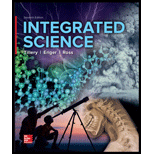
Integrated Science
7th Edition
ISBN: 9780077862602
Author: Tillery, Bill W.
Publisher: Mcgraw-hill,
expand_more
expand_more
format_list_bulleted
Concept explainers
Textbook Question
Chapter 17.3, Problem 5SC
Brief periods of showers are usually associated with which type of cloud?
- a. stratus
- b. cumulus
- c. cirrus
- d. None of the above is correct.
Expert Solution & Answer
Want to see the full answer?
Check out a sample textbook solution
Students have asked these similar questions
2
3
Imagine you are out for a stroll on a sunny day when you encounter a lake. Unpolarized light from the sun is reflected off the lake into your eyes. However, you notice when you put on your vertically polarized sunglasses, the light reflected off the lake no longer reaches your eyes. What is the angle between the unpolarized light and the surface of the water, in degrees, measured from the horizontal? You may assume the index of refraction of air is nair=1 and the index of refraction of water is nwater=1.33 . Round your answer to three significant figures. Just enter the number, nothing else.
Chapter 17 Solutions
Integrated Science
Ch. 17.3 - Prob. 1SCCh. 17.3 - Prob. 2SCCh. 17.3 - Prob. 3SCCh. 17.3 - Prob. 4SCCh. 17.3 - Brief periods of showers are usually associated...Ch. 17.4 - Prob. 6SCCh. 17.4 - Prob. 7SCCh. 17.4 - Prob. 8SCCh. 17.4 - Prob. 9SCCh. 17.5 - Prob. 10SC
Ch. 17.5 - Prob. 11SCCh. 17.5 - Prob. 12SCCh. 17 - Explain the greenhouse effect. Is a greenhouse a...Ch. 17 - Describe how the ozone layer protects living...Ch. 17 - What is wind? What is the energy source for wind?Ch. 17 - Prob. 4CQCh. 17 - Prob. 5CQCh. 17 - Prob. 6CQCh. 17 - Prob. 7CQCh. 17 - Prob. 8CQCh. 17 - Prob. 9CQCh. 17 - Prob. 10CQCh. 17 - Prob. 11CQCh. 17 - Prob. 12CQCh. 17 - Prob. 13CQCh. 17 - Prob. 14CQCh. 17 - Prob. 15CQCh. 17 - Prob. 16CQCh. 17 - Prob. 17CQCh. 17 - Prob. 18CQCh. 17 - Prob. 19CQCh. 17 - Prob. 20CQCh. 17 - Prob. 21CQCh. 17 - Prob. 22CQCh. 17 - Prob. 23CQCh. 17 - Prob. 24CQCh. 17 - Given the current air temperature and relative...Ch. 17 - Explain why dew is not considered to be a form of...Ch. 17 - What are the significant similarities and...Ch. 17 - Prob. 28CQCh. 17 - Prob. 29CQCh. 17 - Prob. 1PEACh. 17 - Prob. 2PEACh. 17 - Prob. 3PEACh. 17 - Prob. 4PEACh. 17 - Prob. 5PEACh. 17 - On the scale of a basketball, how thick, in cm, is...Ch. 17 - Prob. 2PEBCh. 17 - Prob. 3PEBCh. 17 - A helium balloon had a volume of 1.50 m3 when it...Ch. 17 - Prob. 5PEB
Knowledge Booster
Learn more about
Need a deep-dive on the concept behind this application? Look no further. Learn more about this topic, physics and related others by exploring similar questions and additional content below.Similar questions
- 20. Two small conducting spheres are placed on top of insulating pads. The 3.7 × 10-10 C sphere is fixed whie the 3.0 × 107 C sphere, initially at rest, is free to move. The mass of each sphere is 0.09 kg. If the spheres are initially 0.10 m apart, how fast will the sphere be moving when they are 1.5 m apart?arrow_forwardpls help on allarrow_forwardpls help on thesearrow_forward
- pls help on all asked questions kindlyarrow_forwardpls help on all asked questions kindlyarrow_forward19. Mount Everest, Earth's highest mountain above sea level, has a peak of 8849 m above sea level. Assume that sea level defines the height of Earth's surface. (re = 6.38 × 106 m, ME = 5.98 × 1024 kg, G = 6.67 × 10 -11 Nm²/kg²) a. Calculate the strength of Earth's gravitational field at a point at the peak of Mount Everest. b. What is the ratio of the strength of Earth's gravitational field at a point 644416m below the surface of the Earth to a point at the top of Mount Everest? C. A tourist watching the sunrise on top of Mount Everest observes a satellite orbiting Earth at an altitude 3580 km above his position. Determine the speed of the satellite.arrow_forward
- pls help on allarrow_forwardpls help on allarrow_forward6. As the distance between two charges decreases, the magnitude of the electric potential energy of the two-charge system: a) Always increases b) Always decreases c) Increases if the charges have the same sign, decreases if they have the opposite signs d) Increases if the charges have the opposite sign, decreases if they have the same sign 7. To analyze the motion of an elastic collision between two charged particles we use conservation of & a) Energy, Velocity b) Momentum, Force c) Mass, Momentum d) Energy, Momentum e) Kinetic Energy, Potential Energyarrow_forward
arrow_back_ios
SEE MORE QUESTIONS
arrow_forward_ios
Recommended textbooks for you
 An Introduction to Physical SciencePhysicsISBN:9781305079137Author:James Shipman, Jerry D. Wilson, Charles A. Higgins, Omar TorresPublisher:Cengage Learning
An Introduction to Physical SciencePhysicsISBN:9781305079137Author:James Shipman, Jerry D. Wilson, Charles A. Higgins, Omar TorresPublisher:Cengage Learning Horizons: Exploring the Universe (MindTap Course ...PhysicsISBN:9781305960961Author:Michael A. Seeds, Dana BackmanPublisher:Cengage Learning
Horizons: Exploring the Universe (MindTap Course ...PhysicsISBN:9781305960961Author:Michael A. Seeds, Dana BackmanPublisher:Cengage Learning
 College PhysicsPhysicsISBN:9781938168000Author:Paul Peter Urone, Roger HinrichsPublisher:OpenStax College
College PhysicsPhysicsISBN:9781938168000Author:Paul Peter Urone, Roger HinrichsPublisher:OpenStax College Physics for Scientists and Engineers: Foundations...PhysicsISBN:9781133939146Author:Katz, Debora M.Publisher:Cengage Learning
Physics for Scientists and Engineers: Foundations...PhysicsISBN:9781133939146Author:Katz, Debora M.Publisher:Cengage Learning College PhysicsPhysicsISBN:9781285737027Author:Raymond A. Serway, Chris VuillePublisher:Cengage Learning
College PhysicsPhysicsISBN:9781285737027Author:Raymond A. Serway, Chris VuillePublisher:Cengage Learning

An Introduction to Physical Science
Physics
ISBN:9781305079137
Author:James Shipman, Jerry D. Wilson, Charles A. Higgins, Omar Torres
Publisher:Cengage Learning

Horizons: Exploring the Universe (MindTap Course ...
Physics
ISBN:9781305960961
Author:Michael A. Seeds, Dana Backman
Publisher:Cengage Learning


College Physics
Physics
ISBN:9781938168000
Author:Paul Peter Urone, Roger Hinrichs
Publisher:OpenStax College

Physics for Scientists and Engineers: Foundations...
Physics
ISBN:9781133939146
Author:Katz, Debora M.
Publisher:Cengage Learning

College Physics
Physics
ISBN:9781285737027
Author:Raymond A. Serway, Chris Vuille
Publisher:Cengage Learning
A Level Physics – Ideal Gas Equation; Author: Atomi;https://www.youtube.com/watch?v=k0EFrmah7h0;License: Standard YouTube License, CC-BY